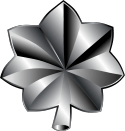United States Army officer rank insignia
United States Army Officer rank insignia in use today.
| US DoD Pay Grade | O-1 | O-2 | O-3 | O-4 | O-5 | O-6 | O-7 | O-8 | O-9 | O-10 | Special | Special | |
|---|---|---|---|---|---|---|---|---|---|---|---|---|---|
| Insignia | |
|
 |
 |
 |
|
|
|
|
|
 |
 | |
| Army Service Uniform Insignia | |
|
|
|
|
|
|
|
|
|
|
| |
| Title | Second Lieutenant |
First Lieutenant |
Captain | Major | Lieutenant Colonel |
Colonel | Brigadier General |
Major General |
Lieutenant General |
General | General of the Army |
General of the Armies | |
| Abbreviation | 2LT | 1LT | CPT | MAJ | LTC | COL | BG | MG | LTG | GEN | GA | GAS | |
| NATO Code | OF-1 | OF-2 | OF-3 | OF-4 | OF-5 | OF-6 | OF-7 | OF-8 | OF-9 | OF-10 | OF-11 | ||
| Non-NATO Code | O-1 | O-2 | O-3 | O-4 | O-5 | O-6 | O-7 | O-8 | O-9 | O-10 | O-11 | O-12 | |
History
The structure of United States military ranks had its roots in British military traditions, adopting the same or similar ranks and titles. At the start of the American Revolutionary War in 1776, uniforms, let alone insignia, were barely affordable and recognition of ranks in the field was problematic. To solve this, General George Washington wrote:
"As the Continental Army has unfortunately no uniforms, and consequently many inconveniences must arise from not being able to distinguish the commissioned officers from the privates, it is desired that some badge of distinction be immediately provided; for instance that the field officers may have red or pink colored cockades in their hats, the captains yellow or buff, and the subalterns green."
In 1780, regulations prescribed silver stars for general officers, worn on epaulettes.[1] From 1821 to 1832, the Army used chevrons to identify officer grades, a practice that is still observed at West Point for cadet officers.
In 1832, epaulettes were specified for all officers, and colonels began wearing the familiar eagle insignia. The epaulettes worn by the infantry were silver, while all other branches had gold epaulettes. In order that the rank insignia would be clearly discernible, they were of the opposite color; that is, the infantry colonels had an eagle of gold because it was placed on a silver epaulette and all other colonels had silver eagles on gold epaulettes. No insignia existed yet for lieutenant colonels, majors, captains, and lieutenants—the length and size of the fringe showing the difference of grade.[1]
In 1836, shoulder straps were adopted to replace the epaulette for field duty. The straps followed the same color combination as the epaulettes; that is, the border was gold with silver insignia for all officers except those of infantry which had silver border with gold insignia. At that time, lieutenant colonels and majors were authorized leaves, captains were authorized two bars, and first lieutenants were authorized one bar on the shoulder straps.[1]
In 1851, it was decided to use only silver eagles for colonels, as a matter of economy. The silver eagle was selected based on the fact that there were more colonels with the silver eagle that those with gold, primarily in the cavalry and artillery, hence it was cheaper to replace the numerically fewer gold ones in the infantry. At that time on the shoulder straps, lieutenant colonels wore an embroidered silver leaf; majors wore a gold embroidered leaf; and captains and first lieutenants wore gold bars. The second lieutenant had no grade insignia, but the presence of an epaulette or shoulder strap identified him as a commissioned officer.[1] For majors, the shoulder strap contained an oak leaf, but like the second lieutenant, the epaulette had no grade insignia. However, the major was still distinguishable from the second lieutenant due to the more elaborate epaulette fringes worn by field grade officers.
In 1872, epaulettes were abolished for officers and replaced by shoulder knots. As the shoulder knots had no fringe, it was necessary that some change in the insignia on the dress uniform be made in order to distinguish the major from the second lieutenant. It was natural to use the gold leaf which the major had been wearing on the shoulder strap. In the same year, the bars on the shoulder straps of the captains and first lieutenants were changed from gold to silver.[1]
By 1917 and the time of World War I, the olive drab service uniform had gradually become used more frequently and the blue uniform was worn only in the evenings and on dress occasions. As a result, metal insignia was authorized for wear on the service uniform on the shoulder loop and on the collar of the shirt when worn without a jacket. Shortly after the United States entered the war, only the service olive drab uniform was being worn. The need for an insignia for the second lieutenant became urgent. Among the proposals was one to authorize for that grade a single bar, the first lieutenant two bars, and the captain three bars. However, the policy of making as little change as possible prevailed, and a gold bar was adopted in 1917, following the precedent previously established by the adoption of the major’s insignia.[1]
Silver versus gold
In terms of heraldic tradition, these changes created the curious situation of silver outranking gold. One anecdotal explanation suggested by some NCOs is that the more-malleable gold suggests that the bearer is being "molded" for his or her responsibilities—as a junior company grade officer (while a second lieutenant) or a junior field grade officer (while a major). Another rationale, perhaps originally devised as a tool for recruits to sort out the confusion, proposed that the symbology was expressed as proximity to the heavens. Gold metal is denser, thus deeper in the ground, than silver, followed by leaves on a tree above the metals, with eagles flying above the trees, and finally the stars in the firmament. In actuality, the precedence of silver outranking gold was a consequence of the decision in 1851 to select silver over gold as a matter of economy.[1]
General of the Army / Armies
While not currently in use today, special insignia were authorized by Congress for ten general officers who were promoted to the highest ranks in the United States Army: general of the army, designed as a "five-star" rank, and general of the armies, considered to be the equivalent of a "six-star" rank. Eight generals were promoted to the rank and title General of the Army (Ulysses S. Grant, William Tecumseh Sherman, Philip Sheridan, George Marshall, Douglas MacArthur, Dwight D. Eisenhower, Henry H. Arnold, and Omar Bradley), while two generals were promoted to the higher rank and title of General of the Armies of the United States (George Washington and John J. Pershing).
Congress created the rank of general of the armies specifically for Washington, although while living he never officially accepted the honor. Pershing received the rank in 1919 and was allowed to choose his own insignia; he chose to use four gold stars. While a conjectural design for the rank of general of the armies was proposed using six silver stars when the promotion of Douglas MacArthur to the rank was considered in 1945, no design was ever officially authorized. In 1976, Congressman Mario Biaggi of New York submitted a house resolution granting Washington the promotion. The promotion was effective on July 4, 1976, the bicentennial of the Declaration of Independence. Although Pershing accepted the rank in 1919 and technically had a date of rank that preceded Washington's, the new law specified that no other officer of the United States Army should ever outrank Washington, including Pershing. Hence, effective date of rank notwithstanding, Washington was permanently made superior to all other officers of the United States Armed Forces, past or present.[2]
While no living officer holds either of these ranks today, the General of the Army title and five-star insignia designed in 1944 are still authorized for use in wartime. Congress may promote generals to this rank for successful wartime campaigns, or to give the officer parity in rank to foreign counterparts in joint coalitions, specifically with respect to field marshals.
| Period | 1866–1872 | 1872–1888 | 1919–1939 | 1942–present | 1956–present | ||||||
|---|---|---|---|---|---|---|---|---|---|---|---|
| Insignia | .svg.png) |
 |
|
 |
 | ||||||
| Title | General of the Army1 | General of the Army2 | General of the Armies3 | General of the Army4 | General of the Armies5 | ||||||
| 1 Worn by Grant (1866 to 1872). 2 Worn by Sherman (1872 to 1888) and Sheridan (1888). 3 Insignia chosen by Pershing (authorized 1919 to 1948). 4 Worn by Marshall (1944–1959), MacArthur (1944–1964), Eisenhower (1944–1969), Arnold (1944–1950), and Bradley (1950–1981). 5 Conjectural Design for General of the Armies authorized in 1956. | |||||||||||
See also
- United States Army enlisted rank insignia
- Warrant officer (United States)
- Comparative army officer ranks of the Americas
References
- 1 2 3 4 5 6 7 Use of Silver and Gold Officer Insignia of Rank The Institute of Heraldry, Office of the Administrative Assistant to the Secretary of the Army.
- ↑
 Public Law 94-479. Wikisource. 1976.
Public Law 94-479. Wikisource. 1976.
External links
- US Army Officer Ranks - United States Army website
- Use of Silver and Gold Officer Insignia of Rank The Institute of Heraldry
- US Army Rank and Insignia Courtesy of Georgia State Defense Force
- Department of Defense Rank Insignias — Officers Rank
| United States uniformed services commissioned officer and officer candidate ranks | ||||||||||||||
|---|---|---|---|---|---|---|---|---|---|---|---|---|---|---|
| Pay grade / branch of service | Officer candidate |
O-1 | O-2 | O-3 | O-4 | O-5 | O-6 | O-7 | O-8 | O-9 | O-10 | O-11 (Obs.) |
Special grade | |
| Insignia | |
|
|
|
|
|
|
|
|
|
|
|
| |
| CDT / OC | 2LT | 1LT | CPT | MAJ | LTC | COL | BG | MG | LTG | GEN | GA[3] | GAS[3] | ||
| Midn / Cand | 2ndLt | 1stLt | Capt | Maj | LtCol | Col | BGen | MajGen | LtGen | Gen | [5] | [5] | ||
| MIDN / OC | ENS | LTJG | LT | LCDR | CDR | CAPT | RDML | RADM | VADM | ADM | FADM[3] | AN[3] | ||
| Cadet / OT / OC | 2d Lt | 1st Lt | Capt | Maj | Lt Col | Col | Brig Gen | Maj Gen | Lt Gen | Gen | GAF[3] | [5] | ||
| CDT / OC | ENS | LTJG | LT | LCDR | CDR | CAPT | RDML | RADM | VADM | ADM | [5] | [5] | ||
| [OC] | ENS | LTJG | LT | LCDR | CDR | CAPT | RADM | RADM | VADM | ADM | [5] | [5] | ||
| OC | ENS | LTJG | LT | LCDR | CDR | CAPT | RDML | RADM | VADM | [4] | [5] | [5] | ||
| [1] No universal insignia for officer candidate rank; Navy candidate insignia shown [2]Official 1945 proposal for General of the Armies insignia; John J. Pershing's GAS insignia: [3] Rank used for specific officers in wartime only, not permanent addition to rank structure [4] Grade is authorized by the U.S. Code for use but has not been created [5] Grade has never been created or authorized | ||||||||||||||
| United States warrant officer ranks | |||||
|---|---|---|---|---|---|
| W-1 | W-2 | W-3 | W-4 | W-5 | |
| Army |
WO1 |
CW2 |
CW3 |
CW4 |
CW5 |
| Marine Corps |
WO1 |
CWO2 |
CWO3 |
CWO4 |
CWO5 |
| Navy |
WO1[1] |
CWO2 |
CWO3 |
CWO4 |
CWO5 |
| Air Force |
WO1[1] |
CWO2[1] |
CWO3[1] |
CWO4[1] |
CWO5[1] |
| Coast Guard |
WO1[1] |
CWO2 |
CWO3 |
CWO4 |
[2] |
| PHS Corps |
[2] | [2] | [2] | [2] | [3] |
| NOAA Corps |
[3] | [3] | [3] | [3] | [3] |
| [2] Grade is authorized for use by U.S. Code but has not been created [3] Grade never created or authorized | |||||